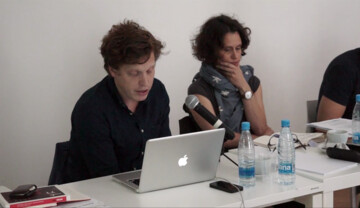It seems the commons differs from the first four referential fields explored by the glossary – historicization, subjectivization, geopolitics and constituencies. The term is propositional whereas the previous terms demarcate broader strategies or areas. Similarly, the commons is closely aligned with a set of political and ideological positions, as well as recent discursive momentum that’s gathered, as the glossary preamble states, over the past decade. For the proposition of the commons to move past its own ‘discursive illusion’, however - to resist becoming an abstraction - it feels significant to consider what we might understand of the commons on a personal, subjective and human level. What does it mean to be in common? What types of relationships – or modes of being together - would that involve? With this in mind, I would like to consider the term ‘friendship’.
My own interest in the notion or practice of ‘friendship’ came from working with the artist Celine Condorelli at the Van Abbe in 2013-14 on an exhibition and a book. Indeed, many of the ideas that I shall draw on arise form Celine’s work and the publication we produced as the culmination of her project, titled The Company She Keeps (Book Works, 2014). Drawing from the relatively brief but rich discourse on friendship – from classical philosophers like Aristotle to contemporary theorists such as Agamben – Condorelli identifies that friendship has, for the most part been considered as friendship between men. Her contribution towards the discourse on friendship then was to look at, through a series of conversations with sociologist Avery Gordon, friendships between outcasts and the excluded, particularly amongst women and slaves.
When considering a term for the glossary I revisited this book and some of the references it maps. I was struck by how we might understand the role of friendship in relation to a project of the commons, how we might consider friendship as a form of solidarity, how friendships between the excluded have provided the grounds and means with which to resist systems of power and elites, and how the concept of the multitude - so closely aligned with that of the commons - might be thought of in terms of an infinite friendship: ‘Friendship in this way’, Johan Hartle says, ‘leads towards the building of a common, the “in common”, or to a form of commoning.’
My consideration of friendship will map some of these references and consider their resonance within the wider exploration of the commons. It will also consider how we might understand friendship from the position of the institution. If one of the definitions we might ascribe to friendship is the development of a common understanding and subsequently intellect between people, how can this be reflected or implicated in the museum and the types of relationships it fosters? Friendships exist without contracts, and by inference without obligations. In this sense, it is unspoken. As Condorelli writes ‘we however, can and do speak to our friends which is already to act in friendship, as a practice, a process’. What would that process engender in an institutional context – either across institutions such as through a project like L’Intenrationale or amongst its various constituents?


